ESSAYS GRADE 12 NOTES - LITERATURE STUDY GUIDE
Share via Whatsapp Join our WhatsApp Group Join our Telegram GroupSection A
Essays
To write a successful exam essay, you need to give yourself time to plan your ideas and write a draft. Once you have edited and corrected your draft, your final essay should be a well-structured and interesting piece of writing.
In this section, you will learn how to express yourself using the rules that will earn you marks in the final Grade 12 exam.
1. All about essays
1.1 The structure of an essay
An essay must have an introduction, a body and a conclusion.
Introduction
The introduction is the first paragraph of an essay. It should catch the reader’s attention and suggest what the essay is about (the topic).
Body
The longest part of an essay is the body of the essay. It is divided into paragraphs. Each paragraph usually contains one main idea about the essay topic.
Conclusion
The last paragraph in an essay is the conclusion. It brings the essay to an end. No new information is given in the conclusion, but it often brings together some key points or ideas.
Vocab
- Coherent - expressed in a clear way that is easily understood
- Logical order - Arranging information so that the points follow each other in an order that makes sense.
Essay structure
|
1.2 Steps for writing an essay in the exams
There are four main steps involved in writing an exam essay:
Step 1: Choose your topic and type of essay
Step 2: Plan your essay
Step 3: Write and edit your draft essay
Step 4: Write your final essay
Step 1: Choose your topic and type of essay
Topic
In the essay section of the exam, there will be about eight topics. You need to choose one of these topics on which to write your essay. You only need to write one essay.
Essay type
A particular topic may suit one type of essay better than another type of essay. For example, if a topic asks whether you agree or disagree, then use the argumentative essay type. The table below shows brief descriptions of the five essay types. See pages 9 to 38 for more information on each essay type.
| The five essay types | ||
| 1 | Narrative essay | It tells a story; will have the word story in the topic; has characters, setting, plot |
| 2 | Descriptive essay | It describes an experience, an event or a place |
| 3 | Reflective essay | It shows how you think or feel about a topic. It shows your emotions, hopes and dreams |
| 4 | Discursive essay | It must present BOTH sides of an issue based on the topic. |
| 5 | Argumentative essay | It must support ONE side of an issue based on the topic |
Hint: Choosing an essay topic in the exam
|
Step 2: Plan your essay
Decide which type of essay you think is most suitable for the essay topic.
Remind yourself of the features of this type of essay.
Plan your essay by writing down your ideas for the content of the essay. The content refers to the main ideas (points or details) in your essay – what it is mainly about. It must be relevant to the topic.
Once you have written down a few ideas, you can organise them by numbering them. This will show the order of your paragraphs for the structure of your essay.
There are many different ways to plan an essay. For example, you could use a mind map. Use the planning method that works best for you. There are examples of planning tools on pages 5 and 6.
Essay content planning
|
Ways to plan an essay
A plan helps you think about what ideas you want to include in your essay. It also helps you put your ideas into a clear structure. You will earn marks for showing your planning.
You can use a mind map or an ideas list to plan your essay.
1. Mind maps
These are diagrams of ideas. The title is in the center with branches coming from it showing thoughts and ideas. Below is an example of a mind map.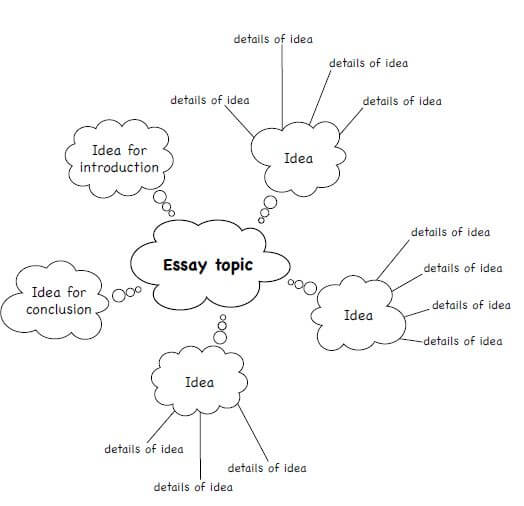
2. Idea lists
These help you to quickly write down ideas for each paragraph. Write down your ideas as they come to you and then organise them in a logical order. Below is an example.
Step 3: Write and edit your draft essay
Write a draft of your essay, using the ideas from your plan.
Read through each sentence carefully to proofread it. Look for any spelling, punctuation or other language mistakes. Edit your draft by correcting these mistakes and making any other changes you think are needed.
This will improve your language and writing style in your final essay.
Count the number of words in your essay and make any changes to meet the word limit. For example, you may need to add some words or use fewer words.
NOTE:
- An essay must be between 250 to 300 words long.
Hint:
|
- The way you write your essay creates a style of writing. The words you chose and the length of your sentences are two examples of how a writing style is created.
- Think about your audience to help you chose the right register for your essay. Register can be formal. For example; if your audience is a teacher or informal if your andience is for example a friend.
- The tone of the essay is the feling the write gives the writing. For example, the tone could be playful or serious.
Step 4: Write your final essay
Write your final essay by rewriting your draft. Make sure that you make all the changes you marked in your draft so that your final essay has no mistakes and clearly expresses all your best ideas.
When you have finished your final essay, cross out your planning and draft essay. If you do not do this, the examiner may mark your draft and not your final essay.
Hint:
|
2. The five essay types
There are different types or genres of essays. Each type is written for a different purpose. To prepare for the exam, you need to revise how to write five types of essay:
- Narrative essays
- Descriptive essays
- Reflective essays
- Discursive essays
- Argumentative essays
The main features of each type of essay and guidelines for writing each type of essay are given in this section. To prepare for the exam, practice writing the different types of essays.
2.1 Narrative essays
A narrative essay tells a story or describes a sequence of events. It can be written from any perspective (first person or third person narrative). The first person narrator will use the pronouns “I” or “we”, while the third person narrator will use pronouns such as “he”, “she”, “they” and “them”.
A narrative essay can include dialogue (speech between characters in the story) and often includes interesting descriptions. This helps the reader to imagine what is happening, so the story comes alive.
| Hint: In a narrative essay, you must tell a story
|
A learner’s example of a narrative essay using the four steps
Step 1: Choose the topic and type of essay
- This learner chose this essay topic because it fitted a narrative essay type:
I am an old desk in a classroom and this is my story…
Note: Write a narratiove if the word "story" is in the description. Always give your essay a title.
Step 2: Plan the essay
The learner used a mind map to plan her essay.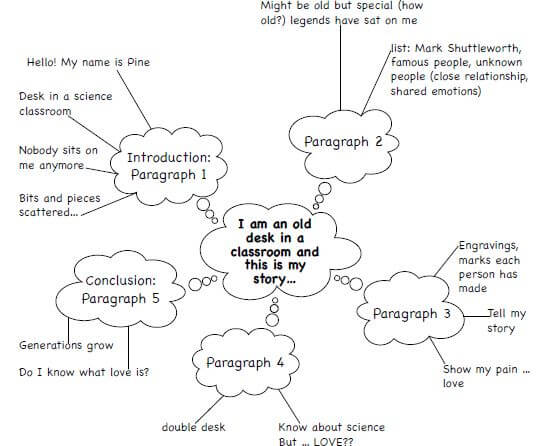
Step 3: Write and edit the draft essay
Editing means checking your draft and correcting any grammar, punctuation and spelling errors. You can also change your word choice to make your writing stronger.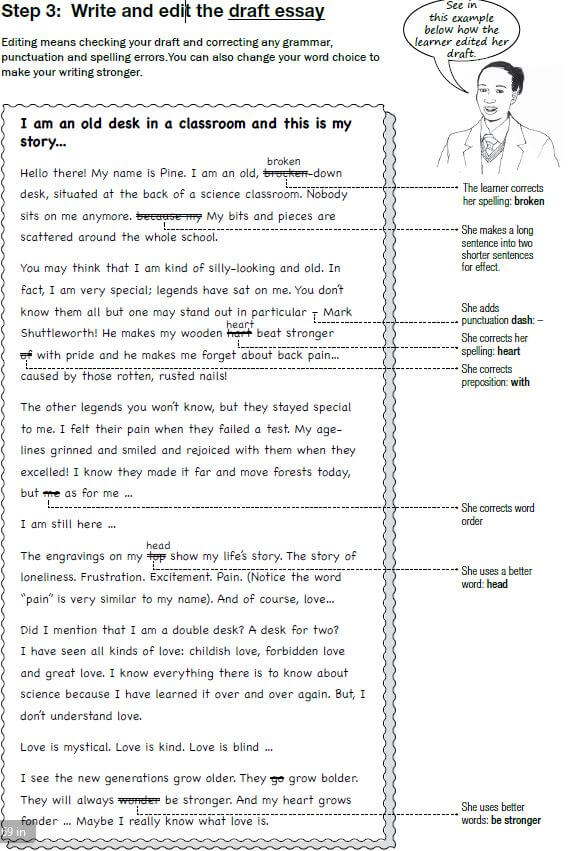
Step 4: Write the final essay
Note: By including her edits from her draft essay, the learner greatly improved her final essay.
I am an old desk in a classroom and this is my story… |
word count: 262
Main features of a narrative essay that are shown in this learner’s story
Features | Examples in the essay |
Characters
| Pine, learners (including famous people), and lovers, who used the desk |
Plot
| The story has a strong story line. The desk remembers people who have used it, and how they made it feel. It ends with the climax - as the desk realises that it loves learners who use it. |
Setting
| The science classroom. |
Theme
| The movement of learners through the classroom - they move on as they grow up, but the desk remains. The meaning of love. |
Structure
| From the past to the present, looking ahead to the future; from the concrete to the abstract. |
Creative use of language | Strong, interesting words are used, for example: age-lines, legends, scattered move forests, rejoice, excelled, rotten, frustration, forbidden love, mystical. Short sentences and paragraphs add impact. |
Activity: Writing a narrative essay
Here are some narrative essay topics to help you to practice your writing skills:
- Write a story that includes the following words:
Suddenly there was absolute silence...
NOTE: The words given in the topic MUST be included somewhere in your essay. - Write a story that begins with the following words:
It was the greatest day of my life.
NOTE: The words given in the topic MUST be used in the first sentence of your introduction.
2.2 Descriptive essays
In a descriptive essay, the writer describes an experience, an event, a situation, an object or a person. The purpose is to allow the reader to imagine what is being described as clearly as possible. Writing a descriptive essay is like creating a picture with words, rather than telling a story.
Hint:
|
A learner’s example of a descriptive essay using the four steps
Step 1: Choose the topic and type of essay
This learner chose this essay topic because it fitted a descriptive essay type:
The scene in the waiting area of a clinic OR a doctor’s surgery.
Note; The word scene in the topic sentence suggests that a descriptive essay is appropriate for this topic
Step 2: Plan the essay
The learner used a mind map to plan his essay.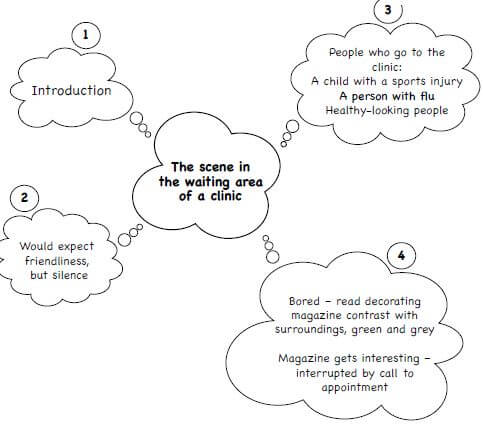
Step 3: Write and edit the draft essay
Editing means checking your draft and correcting any grammar, punctuation and spelling errors. You can also change your word choice to make your writing stronger.
Step 4: Write the final essay
The scene in the waiting area of a clinic A clinic waiting area is possibly one of the most awkward places to be. You come in through the door, go to reception to tell the friendly lady that you are here for an appointment with the doctor and as you go to take a seat, you politely nod to all the other people. |
word count: 271
Main features of a descriptive essay that are shown in this learner’s essay
Features | Examples in the essay |
Characters
| Receptionist, the child, the mother, other people waiting in the queue |
Plot
| Description and observation of events from the moment of registration with the receptionist up to the point where the patient is called to see the doctor. |
Setting
| The waiting area of the clinic. |
Theme
| Awkwardness of being in a small public space with strangers. |
Structure
| The events move from the arrival up to the point when the doctor is ready to see the patient. |
Creative use of language | Strong, interesting words are used, for example; hysterical, flu-like symptoms, calm and collected man, coloured pale green and grey. |
Activity: Writing a descriptive essay
Here are some descriptive essay topics to help you to practise your writing skills:
- Write an essay on the following topic:
Life with my neighbors - Write an essay on the following topic :
It was a dream come true!
NOTE: The words given in the topic MUST be included somewhere in your essay. - Write an essay on the following topic :
An amazing performance.
2.3 Reflective essays
A reflective essay is written to explain what the writer thinks, and/or feels, about an object, an idea, a situation or an experience. It is subjective (based on the writer’s personal experience) and uses first person pronouns (“I”, “we”, “us”).
A reflective essay usually includes the writer’s emotional reactions or feelings. It could be about, for example, a dream, your hopes for the future or a past event.
Subjective - Your own personal feelings and point of view
In a reflective essay, you write your thoughts, hopes and dreams about the essay topic
|
A learner’s example of a reflective essay using the four steps
Step 1: Choose the topic and type of essay
This learner chose this essay topic because it fitted a reflective essay type:
Things I would like to achieve by the time I am 30.
A reflective essay will be about what you think and feel about a topic. It shows your emotions, hopes and dreams.
Step 2: Plan the essay
The learner used a mind map to plan her essay.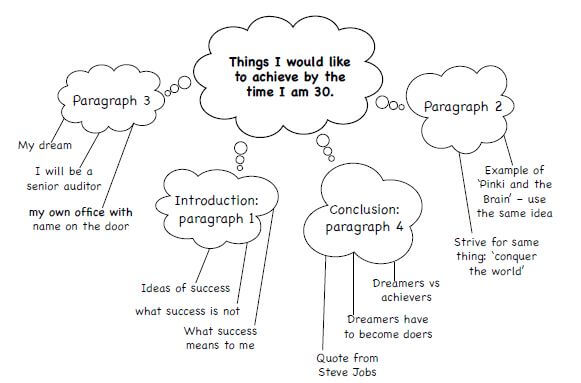
Step 3: Write and edit the draft essay
Editing means checking your draft and correcting any grammar, punctuation and spelling errors. You can also change your word choice to make your writing stronger.
Step 4: Write the final essay
Note: Leave a line between each paragraph to make your essay easy to read.
Things I would like to achieve by the time I am 30 There are a number of things success is not. It’s not money or power, although I have to admit these do have a certain ring to them. Success is bounding out of the door in the mornings because you can’t bear to contain the excitement of going to work (a bit pretentious, but you get the point). Success is bringing together people with universal dreams and inspiring the people you work with to walk the extra mile. |
word count: 260
Main features of a reflective essay that are shown in this learner’s essay
Features | Examples in the essay |
Characters
| The speaker (the writer) is the main person in this story, as it is about personal hopes and dreams. Steve Jobs is quoted as an inspiring person. |
| Introduction | The writer introduces the main idea for the essay - "success". |
| Body | The writer's viewpoint is supported by examples of what personal success means to the writer. |
Creative use of language | Strong, interesting words are used, for example; success is bounding out of the door, universal dreams, walks the extra mile, conquer the world, brainwashed, a white picket fence with two-point0five angelic children. |
Activity: Writing a reflective essay
Here are some reflective essay topics to help you to practise your writing skills:
- Write an essay that includes the following words:
‘I wish I hadn’t ...’
NOTE: The words given in the topic MUST be included somewhere in your essay. - Write an essay that includes the following words:
As I looked at that photograph ...
NOTE: The words given in the topic MUST be included somewhere in your essay. - Write an essay that includes the following words:
This experience has made me realise that ...
NOTE: The words given in the topic MUST be included somewhere in your essay.
2.4 Discursive essays
The word “discursive” comes from the word “discourse” which means the sharing of thoughts and ideas.
A discursive essay presents both sides of an argument. Its purpose is to tell the reader about various sides of a topic. This could be the advantages and disadvantages of something, or the reasons for or against a particular point of view.
It must be objective (looking at both sides equally), and give a balanced view. In the conclusion, the writer usually gives a summary of the main points, and suggests, or recommends, some action or way forward.
In the conclusion, the writer may state the opinion, or view, with which he or she personally agrees. However, the reasons for that decision must be clearly shown in the essay.
Objective - giving a general point of view
Hint:
|
A learner’s example of a discursive essay using the four steps
Step 1: Choose the topic and type of essay
This learner chose this essay topic because it fitted a discursive essay type:
Freedom of choice has both advantages and disadvantages
Discuss this statement.
- In a discursive essay you must present
BOTH sides of an issue. For example, the advantages AND disadvantages of a topic.
Step 2: Plan the essay
The learner used a list to plan his essay.
TOPIC: Freedom of choice - advantages and disadvantages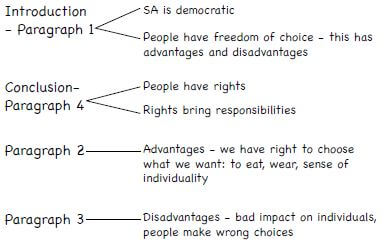
Step 3: Write and edit the draft essay
Editing means checking your draft and correcting any grammar, punctuation and spelling errors. You can also change your word choice to make your writing stronger.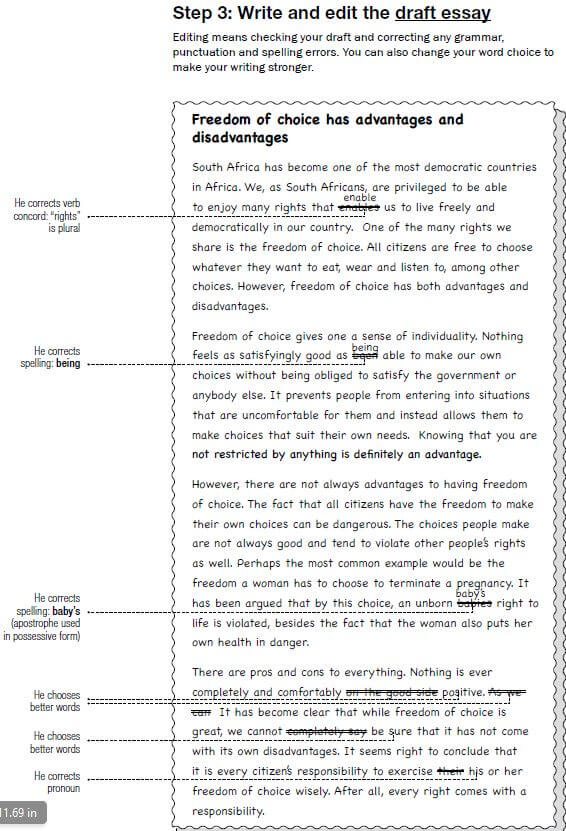
Step 4: Write the final essay
| Freedom of choice has advantages and disadvantages South Africa has become one of the most democratic countries in Africa. We, as South Africans, are privileged to be able to enjoy many rights that enable us to live freely and democratically in our country. One of the many rights we share is the freedom of choice. All citizens are free to choose whatever they want to eat, wear and listen to, among other choices. However, freedom of choice has both advantages and disadvantages. Freedom of choice gives one a sense of individuality. Nothing feels as satisfyingly good as being able to make our own choices without being obliged to satisfy the government or anybody else. It prevents people from entering into situations that are uncomfortable for them and instead allows them to make choices that suit their own needs. Knowing that you are no† restricted by anything is definitely an advantage. However, there are not always advantages to having freedom of choice. The fact that all citizens have the freedom to make their own choices can be dangerous. The choices people make are not always good and tend to violate other people’s rights as well. Perhaps the most common example would be the freedom a woman has to choose to terminate a pregnancy. It has been argued that by this choice, an unborn baby’s right to life is violated, besides the fact that the woman also puts her own health in danger. There are pros and cons to everything. Nothing is ever completely and comfortably positive. It has become clear that while freedom of choice is great, we cannot be sure that it has not come with its own disadvantages. It seems right to conclude that it is every citizen’s responsibility to exercise his or her freedom of choice wisely. After all, every right comes with a responsibility. |
Word count: 300
Features | Examples in the essay |
Content | The writer presents two sides of the argument, and makes a judgement at the end of the essay |
Introduction | The writer introduces the main idea for the essay - freedom of choice. |
Body | The writer presents both the advantages and disadvantages of freedom of choice. The writer organises the paragraphs by presenting arguments for, followed by arguments against, the topic. The concluding line shows the writer's personal view. |
Creative use of language | Strong, interesting words are used, for example; Freedom of choice gives one a sense of individuality; the choices people make are not always good and tend to violate other people's rights as well; an unborn baby's right to life is being violated; nothing is ever completely and comfortably positive. |
Activity: Writing a discursive essay
Here are some descriptive essay topics to help you to practise your writing skills:
- Sport can unite or divide people.
Discuss your views. - Do subjects offered at school prepare you for life?
Discuss your views. - Wearing school uniform is very important.
Do you agree?
Discuss your views on wearing school uniform.
2.5 Argumentative essays
In an argumentative essay, the writer expresses his or her opinion or viewpoint on a topic. The purpose of the essay is to try to convince, or persuade, the reader to agree with that opinion. The writer’s opinion about the topic is clear throughout the essay. It is a subjective essay, and strong personal opinions may be expressed.
In an argumentative essay, you must express your personal opinion about the topic
|
In an argumentative essay you must take a stand on a topic and then support your point of view.
A learner’s example of an argumentative essay using the four steps
Step 1: Choose the topic and type of essay
This learner chose this essay topic because it fitted an argumentative essay type:
Today young people are influenced more by their friends than by their parents.
Do you agree?
Step 2: Plan the essay
This learner used a list to plan her essay.
Topic: Influences on youth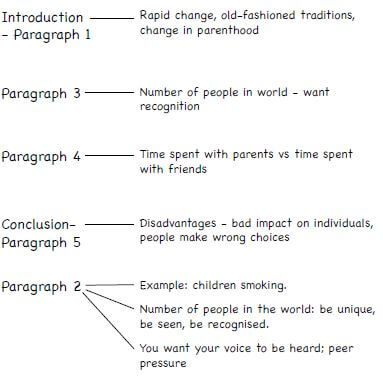
Step 3: Write and edit the draft essay
Editing means checking your draft and correcting any grammar, punctuation and spelling errors.
You can also change your word choice to make your writing stronger.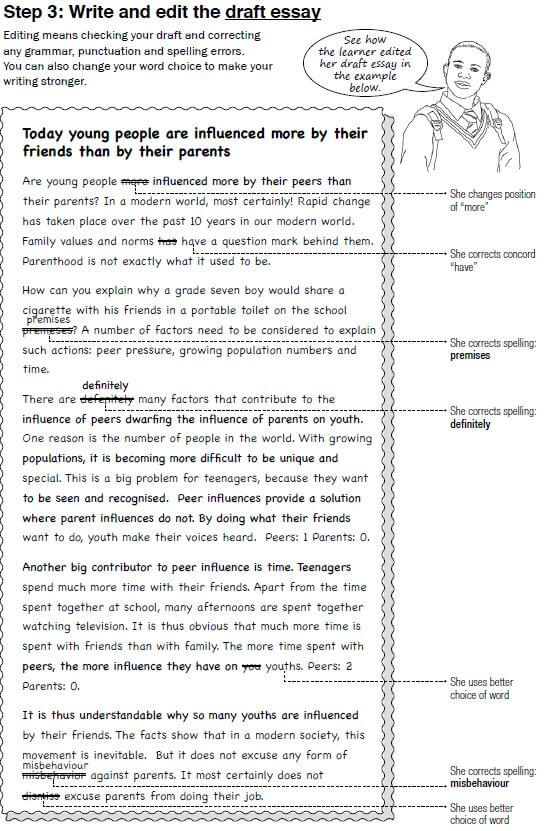
Step 4: Write the final essay
| Today Young People Are More Influenced By Their Friends than by Their Parents Are young people influenced more by their peers than their parents? In a modern world, most certainly! Rapid change has taken place over the past 10 years in our modern world. Family values and norms have a question mark behind them. Parenthood is not exactly what it used to be. How can you explain why a grade seven boy would share a cigarette with his friends in a portable toilet on the school premises? A number of factors need to be considered to explain such actions: peer pressure, growing population numbers and time. There are definitely many factors that contribute †o †he influence of peers dwarfing †he influence of parents on youth. One reason is the number of people in the world. With growing populations, it is becoming more difficult †o be unique and special. This is a big problem for teenagers, because they want to be seen and recognised. Peer influences provide a solution where parent influences do not. By doing what †heir friends want to do, youth make their voices heard. Peers: 1 Parents: 0. Another big contributor †o peer influence is †time. Teenagers spend much more time with their friends. Apart from the time spent together at school, many afternoons are spent together watching television. It is thus obvious that much more time is spent with friends than with family. The more time spent with peers, †he more influence †hey have on youths. Peers: 2 Parents: 0. *I† is thus understandable why so many youths are influencing by their friends. The facts show that in a modern society, this movement is inevitable. But it does not excuse any form of misbehavior against parents. It most certainly does not excuse parents from doing their job. |
Word count: 282
Main features of an argumentative essay that are shown in this learner's essay
Features | Examples in the essay |
Content | The writer begins with a general statement and moves on to explain her point of view. The viewpoint is supported with good reasons. |
Introduction | The writer introduces the main idea for the essay by giving some background to the topic. |
Body | The writer supports her viewpoint with examples. Related facts are combined within paragraphs. Use is made of connecting words to back up the argument. For example, How else can you explain; but; thus |
Creative use of language | Strong, interesting words are used. For example, values and norms; peers; dwarfing the influence of parents; in a modern society this movement is inevitable. |
Activity: Writing an argumentative essay
Here are some argumentative essay topics to help you to practise your writing skills:
- Most teenagers today do not pay much attention to leading a healthy life.
Do you agree? - Technology has changed the lives of teenagers.
Do you agree? - Should alcohol and cigarettes be advertised in the mass media?
Discuss your views.
2.6 Writing an essay from a picture
There is always a question in the exam that asks you to write an essay based on a picture. You only need to write an essay about ONE of the pictures. Choose which picture you are going to write about. Then you need to decide what type of essay you are going to write. The content of your essay must link with the picture.
Looking closely at the picture, identify information you can use in your essay. For example, the picture below shows a man who is:
- Laughing/smiling
- Dressed smartly in a shirt and tie
- Holding a baby
- Speaking/listening on the telephone
- Writing something in a book/diary
There are five different types of essay that could be written about this picture, as shown below.
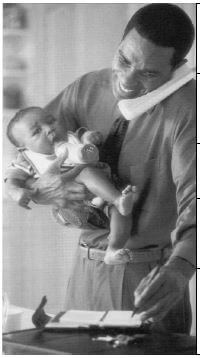 | 1. A narrative essay
|
2. A reflective essay
| |
3. A descriptive essay
| |
4. A discursive essay
| |
5. An argumentative essay
|
A learner’s example of an essay from a picture using the four steps
Step 1: Choose the topic and type of essay
This learner chose to write a reflective essay based on this picture of a watch:
Step 2: Plan the essay
This learner used a mind map to plan his essay.
Step 3: Write and edit the draft essay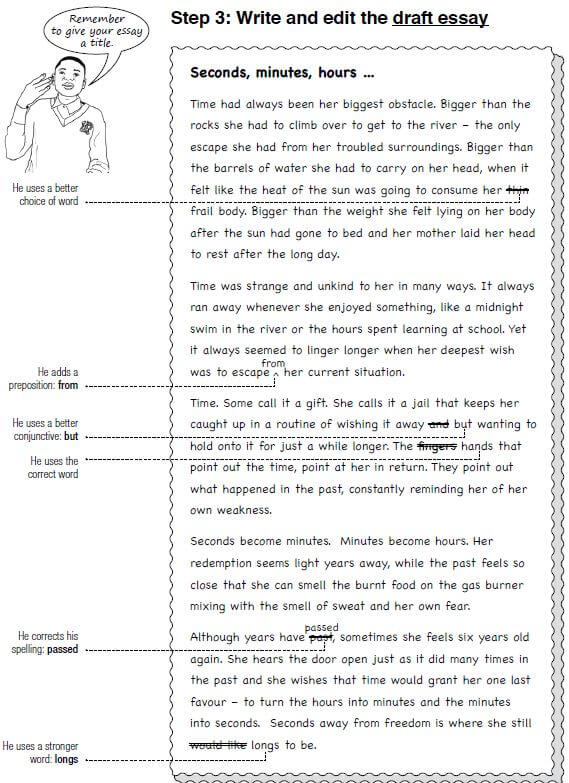
Step 4: Write the final essay
| Seconds, minutes, hours... Time had always been her biggest obstacle. Bigger than the rocks she had to climb over to get to the river – the only escape she had from her troubled surroundings. Bigger than the barrels of water she had to carry on her head, when it felt like the heat of the sun was going to consume her frail body. Bigger than the weight she felt lying on her body after the sun had gone to bed and her mother laid her head to rest after the long day. Time was strange and unkind to her in many ways. It always ran away whenever she enjoyed something, like a midnight swim in the river or the hours spent learning at school. Yet it always seemed to linger longer when her deepest wish was to escape from her current situation. Time. Some call it a gift. She calls it a jail that keeps her caught up in a routine of wishing it away but wanting to hold onto it for just a while longer. The hands that point out the time, point at her in return. They point out what happened in the past, constantly reminding her of her own weakness. Seconds become minutes. Minutes become hours. Her redemption seems light years away, while the past feels so close that she can smell the burnt food on the gas burner mixing with the smell of sweat and her own fear. Although years have passed, sometimes she feels six years old again. She hears the door open just as it did many times in the past and she wishes that time would grant her one last favour – to turn the hours into minutes and the minutes into seconds. Seconds away from freedom is where she still longs to be. |
Word count: 297
Features | Examples in the essay |
Content | The writer has interpreted the picture in a figurative way. That is, the watch reminds the writer of time and how it is linked to the events in someone's life. |
Introduction | The writer introduces the main idea for the essay by giving some background to the topic - time |
Body | In each paragraph, the writer talks about a different aspects of time in the woman's life; and how it did not work in her favour - it was a jail, not a gift. The essay ends with the character wishing that time would go faster, so she can escape from her current situation and be free of her past. |
Creative use of language | Strong, interesting figurative language is used, for example: the metaphor ' hands of time' can refer to the watch as well as to what happens to the character in the story. Alliteration is used in 'linger longer' to emphasise the slow passing of time. |
Activity: Writing an essay from a picture
Choose ONE of the pictures below and write an essay on a topic that comes to mind. Write the question number and give your essay a suitable title/heading.
Note: There must be a clear link between your essay and the picture you have chosen. Use your imagination when answering questions based on pictures. You can interpret them in any way.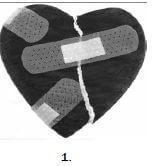
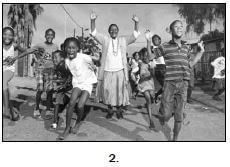
2.7 Essay checklist
Features | Examples in the essay | Yes | No | Don't know |
Essay instructions | I understand the exam instructions for writing an essay. | |||
Essay topic | I understand the essay topic I have chosen. | |||
Essay type | I understand the features of the essay type I have chosen:
| |||
Content and planning | ||||
Planning | I can show evidence of essay planning. | |||
Content | Each point in my plan is relevant to the essay topic. | |||
Purpose/audience | I understand the purpose of the essay type I have chosen. | |||
Structure | ||||
Sentences | I have not repeated sentences in my paragraphs, | |||
Paragraphs | My ideas link and are well organised in paragraphs. | |||
Essay structure | The first paragraph of my essay introduces the topic. | |||
Language, style and editing | ||||
Choice of words/diction | I have chosen my words carefully to make my essay interesting. | |||
Verb tenses | I have used the correct tenses (past, present or future) | |||
Concord | My nouns and verbs are in agreement | |||
Spelling | My spelling is correct | |||
Punctuation | My sentences start with a capital letter and end with a punctuation mark. | |||
3. What is expected from you in the exam?
In the exam, you must write one essay that is no less than 250 and no
more than 300 words long (about 1 to 1 1/2 pages).
The essay is worth 50 marks out of 100 marks in the exam - half the total marks for Paper 3. Examiners will give marks for your essay based on:
- Content and planning (30 marks)
- Language, style and editing (15 marks)
- Structure (5 marks)
The rubric on the next two pages is a table the examiners use to mark your essay. It shows the five levels of achievement that the examiners can award an essay, from the lowest achievement (Inadequate column) to the highest achievement (Exceptional column).
The table also describes the skills the examiner looks for when marking. For example, when marking an essay’s content, the examiner will assess how well the ideas relate to the topic, and whether they are well planned and organised.
The rubric is a useful guide for you to use when practising your essay writing because it reminds you of the skills the examiner will be assessing when marking your exam.
| Criteria | Exceptional | Skilful | Moderate | Elementary | Inadequate | |
| CONTENT & PLANNING (Response and ideas) Organisation of ideas for planning; Awareness of purpose, audience and context 30 MARKS | Upper level | 27–30 | 22–23 | 15-17 | 9-11 | 3-5 |
|
|
|
|
| ||
| Lower level | 24-26 | 18-20 | 12-14 | 6-8 | 0–2 | |
|
|
|
|
| ||
| LANGUAGE, STYLE & EDITING Tone, register, style, vocabulary appropriate to purpose/effect and context; Word choice; Language use and conventions, punctuation, grammar, spelling 15 MARKS | Upper level | 12-13 | 8-9 | 4-5 | 0-1 | |
|
|
|
|
| ||
| Lower level | 13 | 10 | 7 | 4 | ||
|
|
|
| |||
| STRUCTURE Features of text; Paragraph development and sentence construction 5 MARKS | 5 | 4 | 3 | 2 | 0-1 | |
|
|
|
|
|